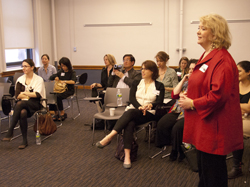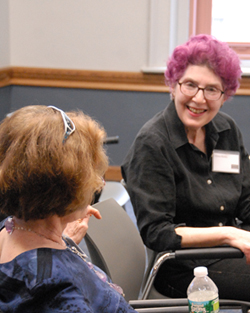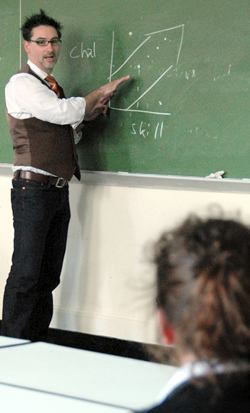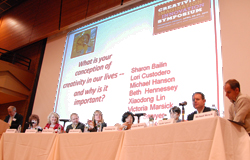Everybody's Talking About Creativity - But Why Do We Need It in the Classroom?
"Many of us enter school as question marks and leave as periods. Why do we squash creativity?"
The question was the focus for a panel of experts that highlighted “Creativity, Imagination and Innovation,” a two-day symposium held at TC in April under the aegis of the College’s Department of Arts and Humanities. Co-chaired by faculty members Margaret Crocco (Social Studies and Education) and Lori Custodero (Music Education), the event included readings by poets from the Nuyorican Poets Café and an evening of experiential workshops in Creativity and the Imagination.
Moderated by Ron Gross, co-chair of the University Seminar on Innovation in Education at Columbia University, the experts’ panel sought both to outline creativity’s role in the classroom and locate its wellspring.
For Michael Hanson, TC faculty member and Director of a Creativity Degree Program at the College, creativity “helps prepare citizens to engage in their world.”
Keith Sawyer, Associate Professor of Psychology at Washington University, defined the outcome of creativity as something that is “new and useful that gets judged as being valuable.”
Xiaodong Lin, Associate Professor of Math, Science and Technology, saw creativity as indispensable to producing results. “At companies like Intel, if they don’t put out something new every three months, they fall behind. Future students face an unpredictable and confusing job market. Much will depend on how creative you are.”
Custodero pointed out the “childlike sense of wonder” that fuels creativity, emphasizing the need to keep an attitude of exploration and discovery alive during the process. “Adults have to deal with self-doubt and judgment,” she said. “As adults, we can draw upon our harmonic beginnings as children and them inform what we do.”
For Beth Hennessey, Professor, Psychology, Wellesley College, motivation and creativity are inseparable. “Students must approach task for the sheer pleasure of engaging in the task,” she said, yet acknowledge the need to balance
excitingly wild flashes of inspiration with the kind of solid information base typically acquired from formal education. “To put all of those things together is an incredible challenge for educators,” she said.
For Michael Wesch, Associate Professor, Anthropology, Kansas State University, new media and the role of sites such as Twitter and Facebook, raise new questions about what it means to be creative in today’s society. “Now, we don’t find ourselves—we create ourselves and that’s the kind of environment I’m trying to create for my students.”
The practical side of creativity came under the microscope at an afternoon panel, “Flourishing in & Surviving the Creative Life,” moderated by Joan Jeffri, Program Coordinator and Director of TC’s Arts Administration Program. The panelists were all professional artists, it was evident that simply keeping afloat required prodigious energy. Yet it was clear that for those who had managed to do so, the act of working within and around practical limitations had, in itself, fostered.
Or as Maxine Greene, TC Professor Emeritus, put it, “Possibility is a wonderful notion—the definition of imagination is the capacity to think of things as being otherwise.”
Yet Greene did not minimize the very real dangers that confront the artist and all human beings. “We can’t comfort ourselves with certainty,” she said. “Anything is possible. We have to educate for crisis tragedy as well as open possibility.”
View the keynote address by Steven Berlin Johnson for Creativity, Imagination and Innovation symposium:
Published Wednesday, Jun. 1, 2011



